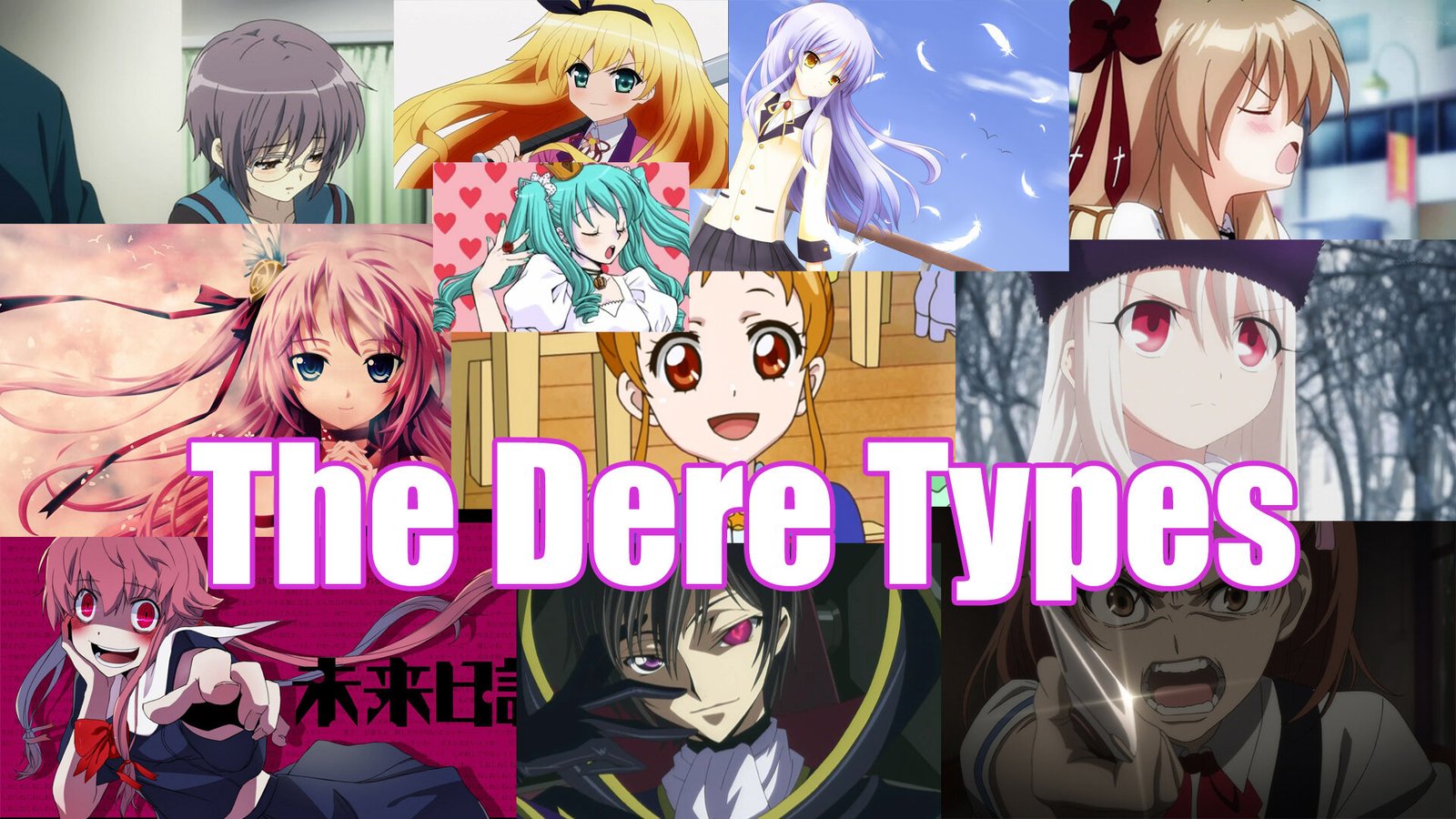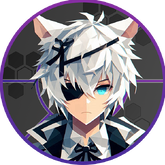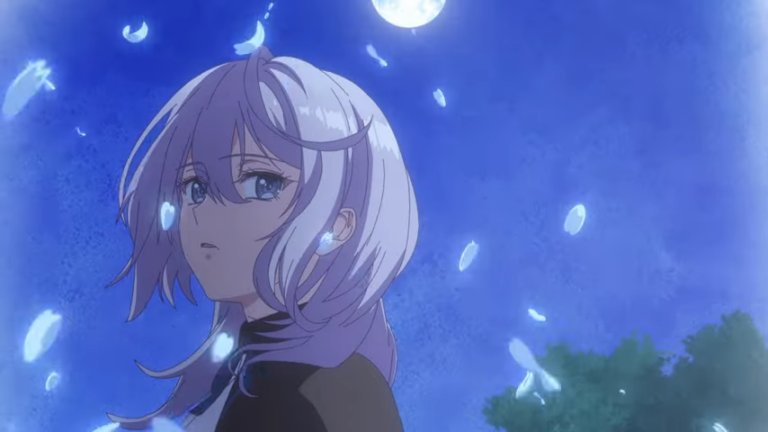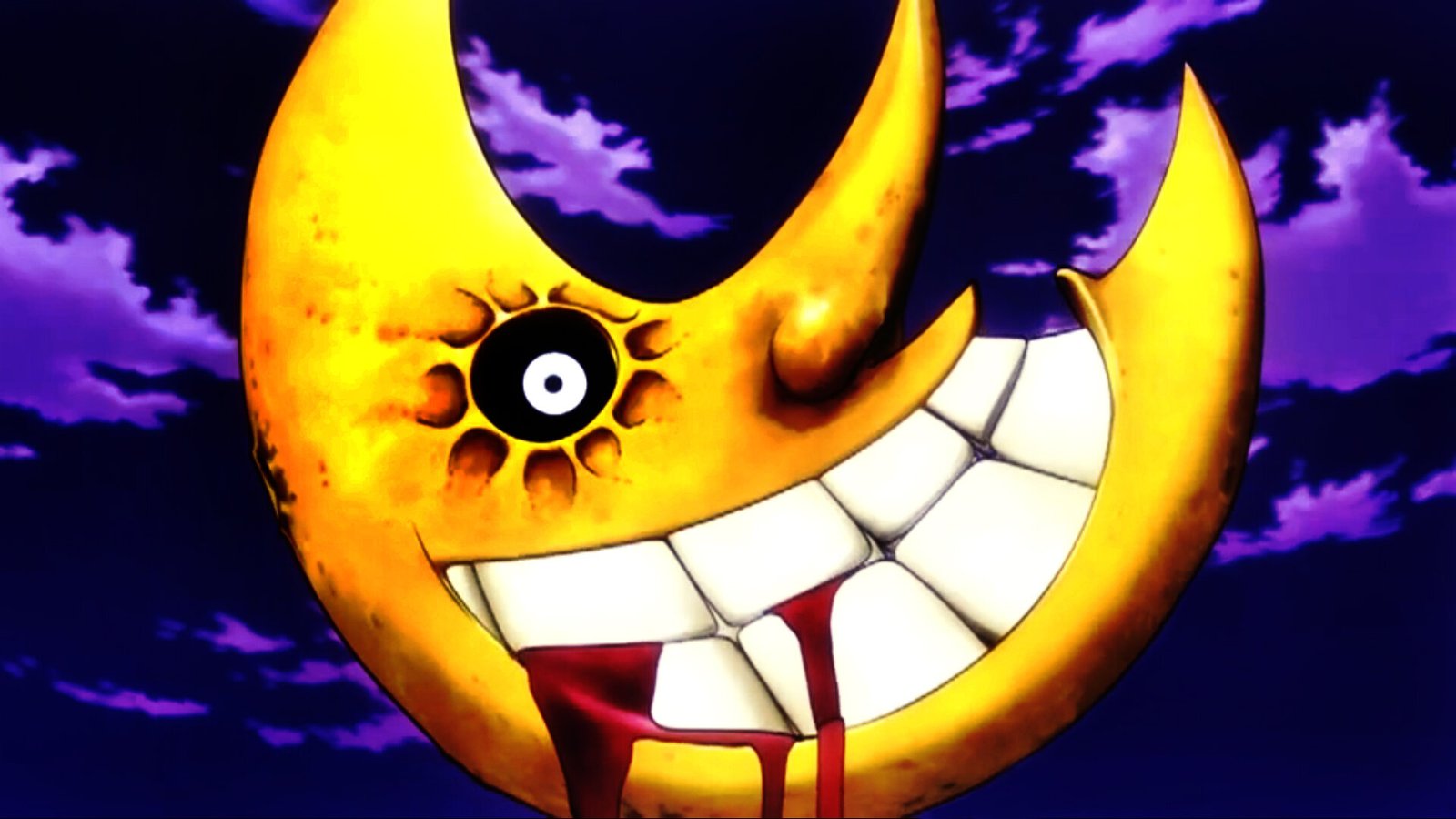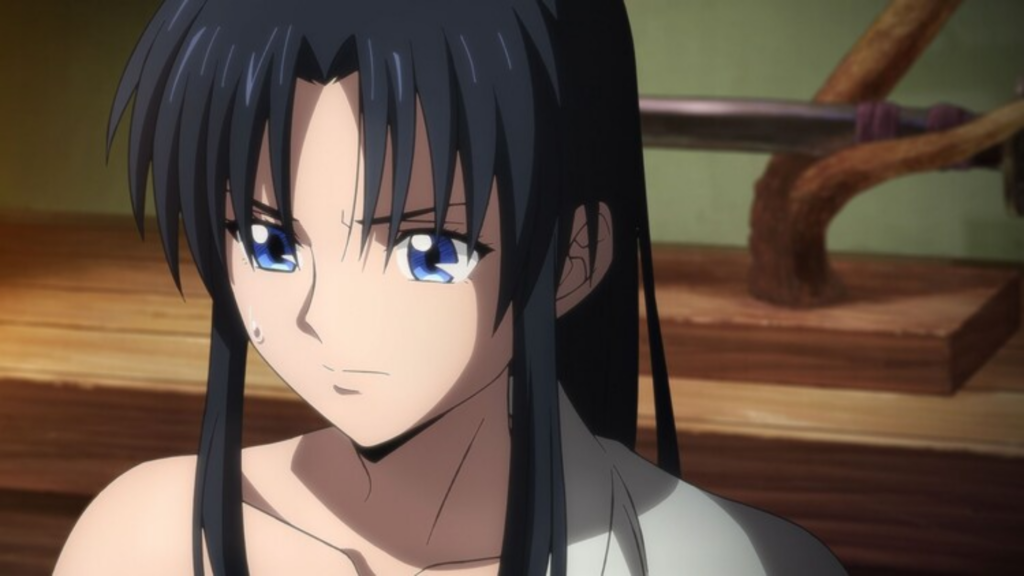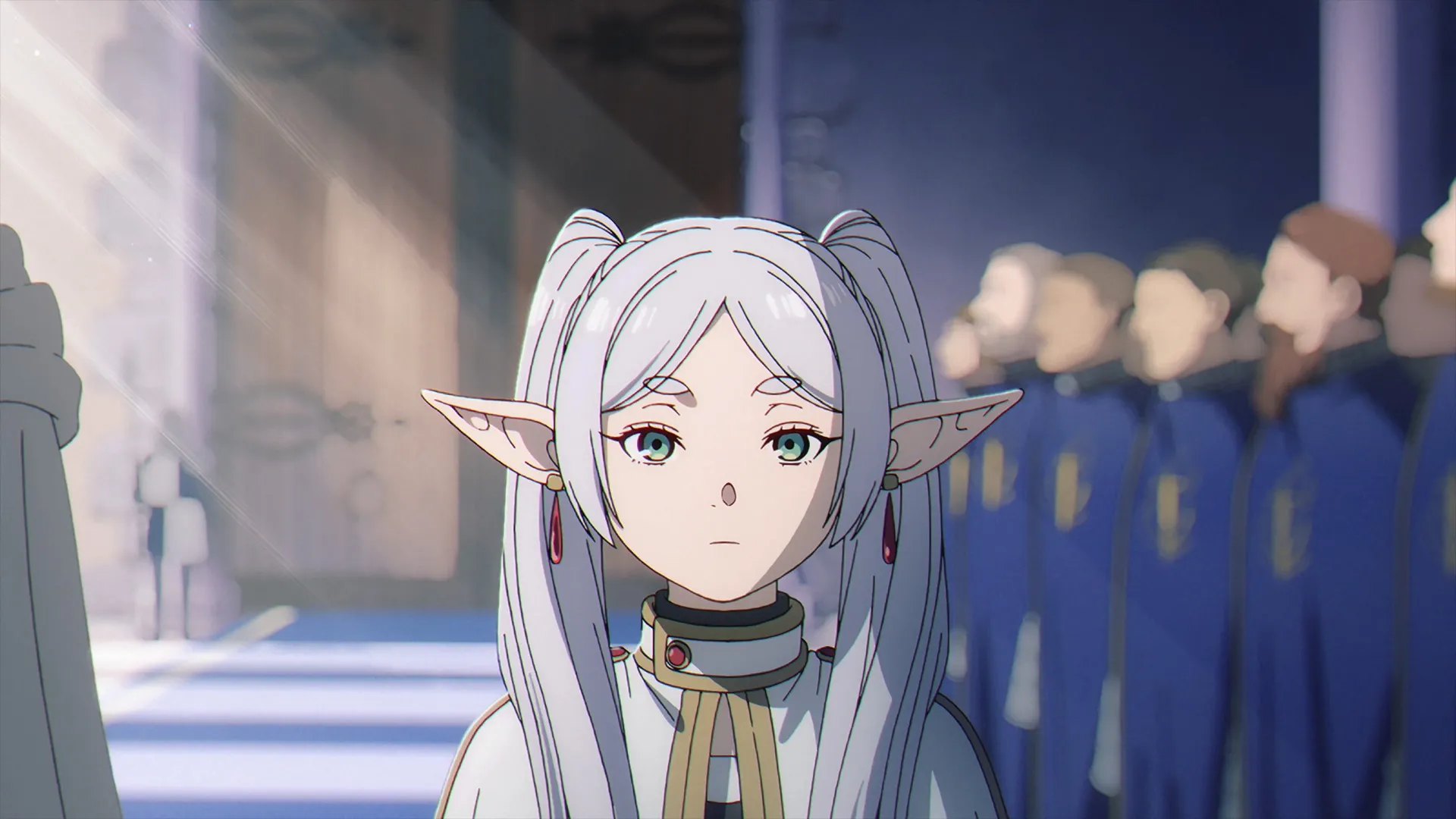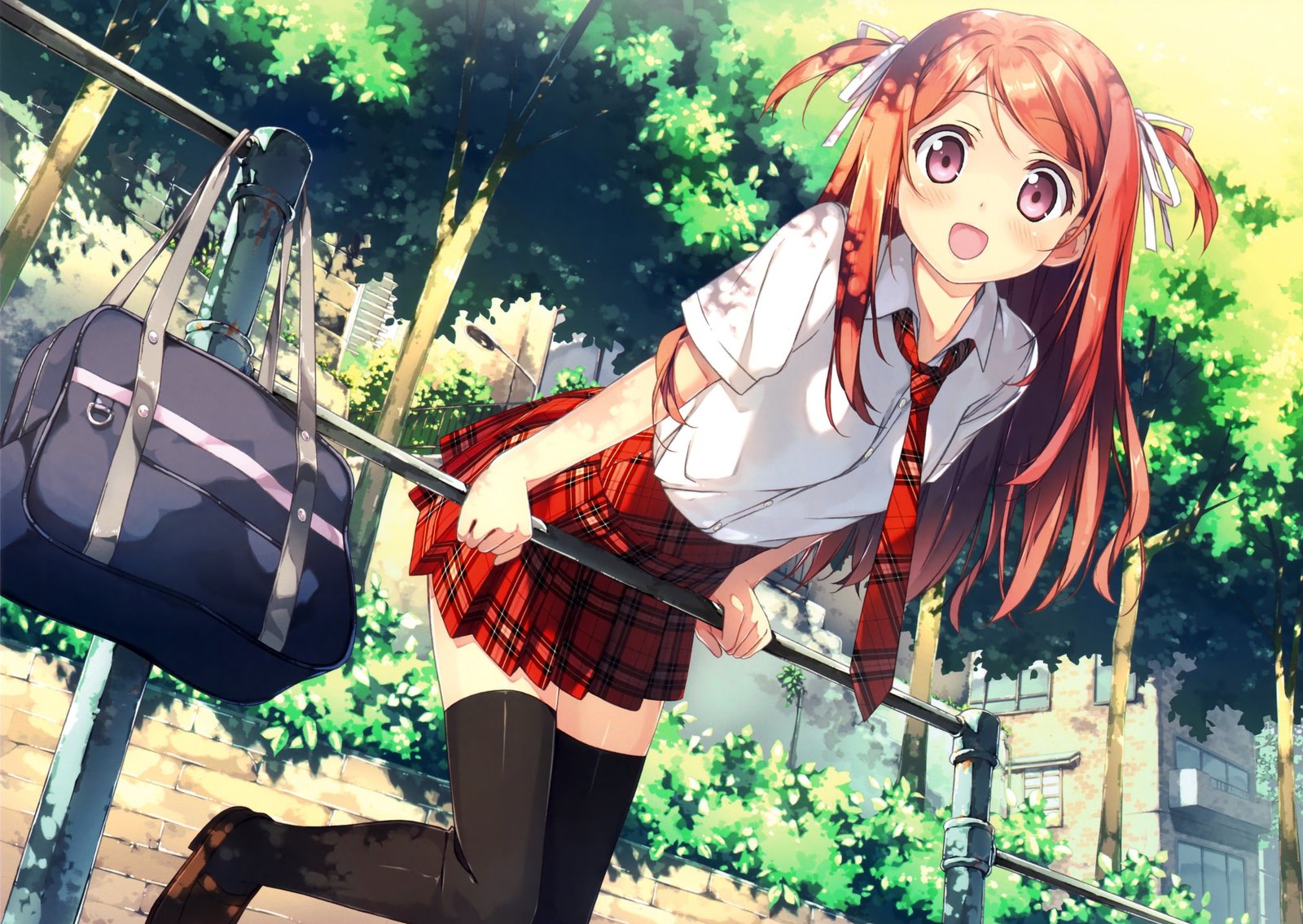In the vibrant world of anime and manga, characters come alive with a kaleidoscope of personalities, each designed to evoke a unique range of emotions and connections. Amid this rich diversity of character archetypes, the concept of "Dere types" stands out as a fascinating and beloved phenomenon. Dere types are character tropes that define a character's behavior and emotions, often portraying distinct facets of their personality. These archetypes, defined by the suffix "dere" in their names, have become a cherished part of the anime and manga culture, shaping the way we understand and relate to the fictional individuals who populate these stories.
From the fiery Tsundere to the enigmatic Yandere, from the stoic Kuudere to the sweet Deredere, each Dere type carries its own set of traits and quirks that leave an indelible mark on the narratives in which they appear. These archetypes serve as both a guide and a source of intrigue for fans and creators alike, allowing for the exploration of complex emotions, character development, and the creation of memorable and relatable characters.
In this exploration of Dere types, we will delve into the twelve most prominent and intriguing archetypes, each with its unique charm and characteristics. From their origins to their enduring appeal, we will uncover what makes these Dere types so captivating and why they continue to play a significant role in shaping the landscape of anime and manga. So, let's embark on a journey through the world of Dere types, where characters' emotions and behaviors are as diverse and colorful as the stories they inhabit.
Tsundere: The Love-Hate Dynamic
Defining the Tsundere
The term "Tsundere" is a portmanteau of two Japanese words: "tsuntsun" (meaning aloof or prickly) and "deredere" (meaning lovestruck or affectionate). Tsundere characters are characterized by:
TsunTsun (Cold Side): At first glance, Tsundere characters often present a cold, aloof, or even hostile demeanor. They may use harsh words, physical aggression, or sarcastic remarks when interacting with their love interest or those they care about.
DereDere (Warm Side): Beneath their tough exterior, Tsundere characters harbor genuine feelings of affection, love, or admiration for someone. As the story progresses, their softer, more affectionate side gradually emerges, revealing their true emotions.
Key Characteristics of Tsundere Characters
Complex Emotions: Tsundere characters navigate complex emotional terrain. Their initial aloofness often masks insecurity or fear of rejection, leading to inner turmoil.
Character Development: The transformation of Tsundere characters from a cold exterior to a warm and loving one is a central theme in many stories. This character development is often marked by personal growth and self-discovery.
Playful Banter: Tsundere characters are known for their playful banter and verbal sparring with their love interest. This dynamic creates humor and tension in the story.
The Appeal of Tsundere Characters
Tsundere characters have a unique and enduring appeal in the world of anime and manga for several reasons:
Complexity: Tsundere characters are multi-dimensional and emotionally complex, making them interesting subjects for character analysis and development.
Relatability: Many viewers can relate to Tsundere characters' struggles to express their true feelings, as well as their fear of vulnerability.
Romantic Tension: The push-and-pull dynamic between the Tsundere's tsun-tsun and dere-dere sides creates romantic tension and excitement for viewers.
Redemption Arcs: Watching Tsundere characters evolve and become more open and loving provides a sense of redemption and emotional satisfaction.
Examples of Tsundere Characters
Anime and manga have introduced numerous iconic Tsundere characters over the years, including:
Taiga Aisaka from "Toradora!" – Taiga is a classic Tsundere, known for her fiery temper and her eventual affection for the protagonist, Ryuuji.
Asuka Langley Soryu from "Neon Genesis Evangelion" – Asuka's abrasive personality conceals deeper insecurities and the desire for companionship.
Rin Tohsaka from "Fate/stay night" – Rin is a strong-willed mage with a tsundere side, particularly when interacting with her love interest, Shirou Emiya.
The Tsundere archetype is a beloved and enduring presence in anime and manga, captivating audiences with its complex emotions, character development, and the satisfying journey from coldness to warmth. Whether you're drawn to their initial tsun-tsun facade, eagerly await their dere-dere moments, or simply appreciate their role in creating romantic tension, Tsundere characters continue to hold a special place in the hearts of fans, reminding us that love, even in its most fiery form, can be a beautiful and transformative force.
Yandere: Love Turns Deadly
Defining the Yandere
The term "Yandere" is a combination of two Japanese words: "yanderu" (meaning mentally ill) and "dere" (indicating a character's affectionate or lovestruck side). Yandere characters are characterized by their:
Fierce Obsession: Yandere characters become obsessively infatuated with their love interest, to the point of being willing to do anything, including violence, to keep them close.
Jekyll and Hyde Persona: They exhibit a dual personality, with a sweet and affectionate "dere" side that can suddenly flip to a psychotic and dangerous "yandere" side when they perceive a threat to their relationship.
Key Characteristics of Yandere Characters
Violence and Aggression: Yandere characters are not afraid to resort to violence or extreme measures to eliminate perceived rivals or obstacles to their love interest.
Delusional Thinking: They may exhibit delusional thinking, believing that their extreme actions are justified by their love or that their love interest desires their protection.
Possessiveness: Yandere characters are possessive to an extreme degree, often isolating their love interest from friends and family to maintain control.
The Appeal of Yandere Characters
Yandere characters, despite their unsettling nature, hold a unique appeal in the world of anime and manga for several reasons:
Psychological Complexity: The duality of their personalities and the psychology behind their obsession make Yandere characters intriguing and thought-provoking.
Intense Drama: The presence of a Yandere character often introduces high-stakes drama and suspense, keeping viewers on the edge of their seats.
Moral Dilemmas: Yandere characters force viewers to grapple with complex moral dilemmas, as they question the boundaries of love and obsession.
Character Development: Some Yandere characters undergo character development, leading to redemption or a deeper exploration of their psychological issues.
Examples of Yandere Characters
Anime and manga feature several memorable Yandere characters, each with their own disturbing and captivating traits:
Yuno Gasai from "Future Diary" – Yuno is perhaps one of the most iconic Yandere characters, with her unrelenting obsession for her love interest, Yukiteru.
Kotonoha Katsura from "School Days" – Kotonoha's descent into madness and violence in pursuit of her love is a chilling example of the Yandere archetype.
Kurumi Tokisaki from "Date A Live" – Kurumi's supernatural abilities and her dangerous obsession add an extra layer of intrigue to her character.
Yandere characters are a compelling but chilling presence in the world of anime and manga. Their extreme obsession, psychological complexity, and capacity for violence make them unforgettable figures in storytelling. While the Yandere archetype may not be for everyone, it continues to be a source of fascination for those who appreciate the exploration of dark and disturbing aspects of human emotions and relationships in fictional worlds.
Deredere: The Unconditional Lover
Defining the Deredere
The term "Deredere" is derived from the Japanese word "dere," which indicates a character's affectionate or lovestruck side. Deredere characters are characterized by:
Unconditional Love: Deredere characters possess an unwavering and unconditional love for others, whether they are friends, family, or a love interest. This love flows naturally from their hearts without any ulterior motives.
Kindness and Optimism: Deredere characters are known for their boundless kindness, compassion, and a generally optimistic outlook on life. They often go out of their way to help others and spread positivity.
Lack of Hostility: Unlike some other character archetypes, Deredere characters do not exhibit hostility, aggression, or negative emotions toward others. They embrace harmony and love as their guiding principles.
Key Characteristics of Deredere Characters
Pure and Heartwarming: Deredere characters exude pure and heartwarming affection, making them a source of comfort, joy, and inspiration for both the characters within the story and the audience.
Reliability: Their unwavering love and support for friends and loved ones make Deredere characters reliable and dependable companions in the world of anime and manga.
Positive Influence: Deredere characters often serve as a positive influence on other characters, inspiring them to be kinder, more compassionate, and to open their hearts to love and friendship.
The Appeal of Deredere Characters
Deredere characters have a unique and enduring appeal in the world of anime and manga for several compelling reasons:
Pure and Heartfelt Love: Deredere characters offer a portrayal of love that is unconditional, pure, and deeply heartwarming. Their positivity and kindness uplift the spirits of viewers.
Relatability: Deredere characters resonate with viewers as they embody the ideals of love, kindness, and optimism that many aspire to in their own lives.
Emotional Resonance: Deredere characters often evoke deep emotional responses from audiences as their affectionate gestures create touching and memorable moments in the story.
Examples of Deredere Characters
Anime and manga feature numerous Deredere characters, each bringing their unique charm to the stories they inhabit:
Nagisa Furukawa from "Clannad" – Nagisa's gentle and caring nature touches the hearts of both her friends and the audience as she faces life's challenges with unwavering optimism.
Mami Tomoe from "Puella Magi Madoka Magica" – Mami combines the Deredere's kindness with the responsibilities of a magical girl, creating a complex character with a heartfelt message.
Honey-senpai from "Ouran High School Host Club" – Honey-senpai's cheerful and affectionate personality adds a sweet touch to the host club and the series as a whole.
Deredere characters shine as beacons of love, kindness, and optimism in the world of anime and manga. Their sincerity, reliability, and positive influence contribute to the overall richness and diversity of character archetypes in storytelling. Whether you're drawn to their pure-hearted nature, their ability to create emotional resonance, or simply find solace in their boundless kindness, Deredere characters continue to serve as a reminder of the enduring power of love and positivity, inspiring viewers to embrace these qualities in their own lives.
Dandere: The Shy and Introverted
Defining the Dandere
The term "Dandere" is a portmanteau of two Japanese words: "danmari" (meaning silence) and "dere" (indicating a character's affectionate or lovestruck side). Dandere characters are characterized by:
Shyness and Introversion: Dandere characters are typically shy, introverted, and reserved in their interactions with others. They often prefer solitude and find it challenging to express their feelings openly.
Gradual Opening Up: Over the course of the story, Dandere characters gradually come out of their shells and become more expressive, especially when around their love interest or close friends.
Key Characteristics of Dandere Characters
Genuine and Sincere: Dandere characters are known for their sincerity and authenticity. Their emotions, while initially hidden, are genuine and heartfelt.
Deep Emotional Complexity: Dandere characters often have complex inner worlds, filled with thoughts and emotions they struggle to articulate. This complexity adds depth to their character development.
Subtle Strength: Their quiet strength lies in their ability to overcome their shyness and grow as individuals, often as a result of their relationships with others.
The Appeal of Dandere Characters
Dandere characters have a unique and enduring appeal in the world of anime and manga for several reasons:
Relatability: Many viewers can relate to the struggles of introversion and shyness, making Dandere characters highly relatable and empathetic figures.
Heartwarming Character Development: Watching Dandere characters gradually open up and become more expressive is a heartwarming and emotionally resonant experience for audiences.
Authenticity: Dandere characters embody authenticity and sincerity, making them a refreshing contrast to more extroverted or exaggerated character types.
Subtle Romance: Dandere characters often play key roles in romantic subplots, creating gentle and nuanced love stories that resonate with viewers.
Examples of Dandere Characters
Anime and manga feature a variety of Dandere characters, each bringing their unique charm to the stories they inhabit:
Yuki Nagato from "The Melancholy of Haruhi Suzumiya" – Yuki starts as a stoic bookworm but gradually reveals her more expressive side as she interacts with the protagonist, Kyon.
Shy Violet from "My Little Pony: Friendship is Magic" – Even outside the anime and manga realm, characters like Shy Violet embody Dandere traits and contribute to diverse narratives.
Kotori Minami from "Love Live! School Idol Project" – Kotori's shyness and gentle demeanor endear her to both her fellow school idols and the audience.
Dandere characters offer a refreshing and heartwarming perspective on the journey from introversion to self-expression. Their sincerity, relatability, and subtle strength make them an integral part of the diverse landscape of anime and manga character archetypes. Whether you're drawn to their quiet authenticity, their emotional complexity, or their role in crafting subtle and touching romance, Dandere characters continue to remind us of the beauty in personal growth and the strength that lies within those who choose to embrace their true selves.
Himedere/Oujidere: Royal Entitlement
Defining the Himedere and Oujidere
The terms "Himedere" and "Oujidere" are character archetypes that draw from the Japanese words "hime" (meaning princess) and "ouji" (meaning prince), respectively. These characters are characterized by:
Noble Entitlement: Himedere and Oujidere characters often possess a sense of royal entitlement, believing themselves to be of noble birth or superior status.
Arrogance: They tend to display a degree of arrogance, looking down upon others and expecting preferential treatment.
Elegant Appearance: Himedere and Oujidere characters are often depicted with elegant attire, emphasizing their royal or princely status.
Key Characteristics of Himedere and Oujidre Characters:
Confidence and Presence: Himedere and Oujidere characters exude confidence and presence, demanding attention wherever they go.
Demands and Expectations: They have a tendency to make demands of others and expect to be catered to, reflecting their entitled personalities.
Hidden Vulnerabilities: Beneath their regal facades, Himedere and Oujidere characters may harbor hidden vulnerabilities or insecurities that humanize them and provide depth to their character development.
The Appeal of Himedere and Oujidere Characters
Himedere and Oujidere characters possess a distinct and intriguing appeal in the world of anime and manga for several reasons:
Extravagant Aesthetics: Their elegant appearances, elaborate costumes, and regal demeanor contribute to visually stunning character designs.
Complexity: The contrast between their haughty exterior and potential inner vulnerabilities adds depth and complexity to their characters.
Dramatic Tension: The interactions between Himedere/Oujidere characters and other, more down-to-earth characters often create dramatic tension and comedic moments.
Character Growth: Himedere and Oujidere characters may undergo character development, leading to a softening of their attitudes and a deeper understanding of themselves and others.
Examples of Himedere and Oujidere Characters
Anime and manga feature several notable Himedere and Oujidere characters, each bringing their unique brand of royal charm to the stories they inhabit:
Himeko Inaba from "Kokoro Connect" – Himeko initially displays Himedere traits but undergoes significant character development as she confronts her vulnerabilities.
Takane Enomoto from "Kagerou Project" – Takane adopts an Oujidere persona as the "Prince," which contrasts with her true self and adds complexity to her character.
Saber from "Fate/Stay Night" – Saber, while not a traditional Himedere or Oujidere, embodies a regal and noble presence as the "King of Knights."
Himedere and Oujidere characters bring a regal and captivating presence to the world of anime and manga, challenging conventions and adding layers of complexity to storytelling. Whether you're drawn to their extravagant aesthetics, their character growth arcs, or the dramatic tension they bring to their narratives, Himedere and Oujidere characters continue to be a cherished and enduring part of the diverse landscape of character archetypes, reminding us of the allure and challenges of nobility and entitlement in fictional worlds.
Bakadere/Ahodere: The Playful Fool
Defining Bakadere and Ahodere
The terms "Bakadere" and "Ahodere" are character archetypes that stem from the Japanese words "baka" (meaning foolish) and "aho" (meaning idiot) respectively, combined with the suffix "dere" (indicating a character's affectionate or lovestruck side). These characters are characterized by:
Playful Foolishness: Bakadere and Ahodere characters exhibit playful and often endearing foolishness in their actions, decisions, and interactions with others.
Cluelessness: They may be blissfully unaware of their own lack of intelligence, often to comically exaggerated degrees.
Lighthearted Optimism: Despite their foolishness, Bakadere and Ahodere characters tend to possess an infectious lightheartedness and optimism that brightens the mood of the story.
Key Characteristics of Bakadere and Ahodere Characters
Childlike Innocence: Bakadere and Ahodere characters often have a childlike innocence about them, approaching life with a sense of wonder and curiosity.
Comedic Timing: Their humorous misunderstandings, nonsensical statements, and slapstick antics contribute to comedic timing and gags in the story.
Unintentional Charm: Their clueless behavior and lack of pretense can make them endearing to both other characters and the audience.
The Appeal of Bakadere and Ahodere Characters
Bakadere and Ahodere characters have a distinct and enduring appeal in the world of anime and manga for several reasons:
Comic Relief: They serve as valuable sources of comic relief, injecting humor into often intense or dramatic narratives.
Infectious Joy: Their childlike optimism and cheerful disposition can be infectious, brightening the overall mood of the story and resonating with viewers.
Unexpected Wisdom: Occasionally, their naive perspectives may lead to unexpected moments of wisdom, adding depth to their characters and the story.
Examples of Bakadere and Ahodere Characters
Anime and manga have introduced a variety of Bakadere and Ahodere characters, each bringing their unique brand of playful foolishness to the stories they inhabit:
Mako Mankanshoku from "Kill la Kill" – Mako is a quintessential Bakadere, often speaking and acting without thinking, providing comic relief in the series.
Haruhara Haruko from "FLCL" – Haruko embodies the Ahodere archetype with her zany antics, clueless behavior, and eccentric charm.
Yui Hirasawa from "K-On!" – Yui's cheerful, carefree attitude and moments of utter cluelessness contribute to the heartwarming humor of the series.
Bakadere and Ahodere characters bring a refreshing and light-hearted element to the world of anime and manga. Their playful foolishness, comedic timing, and boundless optimism serve as essential sources of humor and joy, reminding us that even in the most challenging and dramatic of stories, there's always room for a little bit of blissful silliness.
Kamidere: The Divine Presence
Defining the Kamidere
The term "Kamidere" is a portmanteau of two Japanese words: "kami" (meaning god) and "dere" (indicating a character's affectionate or lovestruck side). Kamidere characters are characterized by:
Divine Presence: Kamidere characters often carry themselves with an air of divinity, viewing themselves as godlike beings with supreme authority.
Charisma and Confidence: They exude charisma, self-assuredness, and an unwavering belief in their own superiority.
Expectation of Worship: Kamidere characters may expect or demand admiration, loyalty, and even worship from others, asserting their divine status.
Key Characteristics of Kamidere Characters
Megalomania: Kamidere characters frequently exhibit megalomaniacal tendencies, believing they are the center of the universe and that others should revolve around them.
Manipulative Charm: They possess a seductive and manipulative charm that allows them to draw others into their orbit, often exploiting their followers' loyalty for personal gain.
Delusions of Grandeur: Kamidere characters may harbor delusions of grandeur, seeing themselves as the saviors, rulers, or masters of their worlds.
The Appeal of Kamidere Characters
Kamidere characters hold a unique and enduring appeal in the world of anime and manga for several reasons:
Charismatic Complexity: Their complex blend of confidence, charisma, and megalomania creates multi-faceted and intriguing characters.
Narrative Tension: The presence of a Kamidere character often introduces tension and conflict, challenging other characters to defy their self-proclaimed authority.
Exploration of Power: Kamidere characters provide a lens through which to explore themes of power, manipulation, and the consequences of unchecked authority.
Examples of Kamidere Characters
Anime and manga feature several noteworthy Kamidere characters, each bringing their unique brand of divine charisma to the stories they inhabit:
Kurumi Tokisaki from "Date A Live" – Kurumi's enigmatic allure, supernatural powers, and belief in her own godlike status make her a compelling Kamidere character.
Esdeath from "Akame ga Kill!" – Esdeath's icy demeanor, unwavering confidence, and obsession with power establish her as a formidable Kamidere antagonist.
Yumeko Jabami from "Kakegurui" – Yumeko combines elements of the Kamidere archetype with a love for high-stakes gambling, creating a character who revels in her own perceived superiority.
Kamidere characters enrich the tapestry of anime and manga with their divine presence, charismatic complexity, and the tension they bring to narratives. Whether you're drawn to their megalomaniacal tendencies, their exploration of power dynamics, or simply their enigmatic charm, Kamidere characters continue to be a fascinating and captivating part of the diverse landscape of character archetypes, reminding us of the allure and complexity of authority and charisma in fictional worlds.
Kuudere: The Cool and Calm Surface
Defining the Kuudere
The term "Kuudere" is a fusion of two Japanese words: "kuu" (meaning cool) and "dere" (indicating a character's affectionate or lovestruck side). Kuudere characters are characterized by:
Stoic Exterior: Kuudere characters maintain a calm, cool, and often emotionless facade, rarely displaying outward signs of affection or emotion.
Emotionally Reserved: They tend to keep their true feelings hidden from others, making it challenging for those around them to discern their emotions
Key Characteristics of Kuudere Characters
Complex Inner World: Kuudere characters often possess complex and nuanced inner thoughts and emotions, which they may struggle to express openly.
Moments of Vulnerability: While they appear unapproachable, Kuudere characters occasionally reveal moments of vulnerability or genuine emotion, often in the presence of someone they trust or care deeply about.
Strong and Independent: Kuudere characters are often portrayed as strong-willed, independent individuals who handle challenges with composure.
The Appeal of Kuudere Characters
Kuudere characters hold a unique and enduring appeal in the world of anime and manga for several reasons:
Enigmatic Charm: Their mysterious and enigmatic nature draws viewers in, prompting them to uncover the depths of the character's emotions and past.
Emotional Complexity: The contrast between their stoic exterior and their hidden emotions adds layers of complexity to their character development.
Moments of Authenticity: The rare moments of vulnerability and genuine emotion are highly impactful, creating powerful and memorable scenes in the story.
Relatability: Many viewers can relate to the idea of concealing their emotions or putting on a brave face in challenging situations, making Kuudere characters highly relatable.
Examples of Kuudere Characters
Anime and manga feature numerous iconic Kuudere characters, each bringing their unique brand of stoic charm to the stories they inhabit:
Rei Ayanami from "Neon Genesis Evangelion" – Rei's stoic demeanor and complex emotions make her an iconic Kuudere character in the world of mecha anime.
Homura Akemi from "Puella Magi Madoka Magica" – Homura's cool and composed exterior masks her deep and tumultuous emotions, adding depth to her character.
Yukino Yukinoshita from "My Teen Romantic Comedy SNAFU" – Yukino's intelligence and stoicism create a sense of mystery, drawing viewers into her character journey.
Kuudere characters bring an intriguing blend of stoicism and hidden depth to the world of anime and manga. Their enigmatic charm, emotional complexity, and moments of vulnerability make them captivating figures in storytelling. Whether you're drawn to their cool exterior, their complex inner worlds, or the authenticity of their rare emotional outbursts, Kuudere characters continue to be a compelling and integral part of the diverse landscape of character archetypes, reminding us of the intricate interplay between emotion and restraint in fictional worlds.
Sadodere: Pleasure in Pain
Defining the Sadodere
The term "Sadodere" is a combination of "sado," derived from the Japanese word "sado-masochism," and "dere," indicating a character's affectionate or lovestruck side. Sadodere characters are characterized by:
Sadistic Tendencies: Sadodere characters often derive pleasure from causing physical or emotional pain to others, either willingly or through manipulation.
Manipulative Behavior: They are skilled at manipulating and controlling those around them, using their allure and charisma to bend others to their will.
Enigmatic Charm: Sadodere characters often possess an enigmatic and seductive charm that draws others into their web of desires and emotions.
Key Characteristics of Sadodere Characters
Dual Nature: Sadodere characters often have a dual nature, oscillating between their sadistic tendencies and moments of genuine affection or vulnerability.
Complex Motivations: The reasons behind their sadistic behavior may vary, ranging from personal trauma to a desire for power and control.
Narrative Conflict: The presence of a Sadodere character often introduces conflict and moral ambiguity into the story, challenging the other characters and the audience to grapple with complex emotions and ethics.
The Appeal of Sadodere Characters
Sadodere characters hold a unique and enduring appeal in the world of anime and manga for several reasons:
Complexity and Depth: The contrast between their sadistic tendencies and moments of vulnerability creates multi-dimensional characters with depth and intrigue.
Moral Ambiguity: Sadodere characters often blur the lines between right and wrong, prompting viewers to question their own moral compass and empathy.
Narrative Tension: The presence of a Sadodere character introduces tension, conflict, and unpredictable plot developments, keeping audiences engaged.
Examples of Sadodere Characters
Anime and manga feature several notable Sadodere characters, each bringing their unique brand of dark desire and manipulation to the stories they inhabit:
Satsuki Kiryuin from "Kill la Kill" – Satsuki is a formidable Sadodere antagonist who combines ruthlessness with a sense of duty and justice.
Rize Kamishiro from "Tokyo Ghoul" – Rize's sadistic tendencies and predatory nature add a layer of horror to the series as she preys on the protagonist, Kaneki.
Kyoko Kirigiri from "Danganronpa: The Animation" – Kyoko's calm and analytical demeanor conceals a complex inner world and hidden desires.
Sadodere characters bring an enigmatic blend of dark desires and emotional complexity to the world of anime and manga. Their seductive charm, moral ambiguity, and narrative tension make them captivating and intriguing figures in storytelling. Whether you're drawn to their manipulative behavior, their moments of vulnerability, or the ethical dilemmas they pose, Sadodere characters continue to be a complex and thought-provoking part of the diverse landscape of character archetypes, reminding us of the multifaceted nature of human desires and emotions.
Shundere: The Delicate and Sensitive
Defining the Shundere
The term "Shundere" is a portmanteau of two Japanese words: "shun" (meaning shy or bashful) and "dere" (indicating a character's affectionate or lovestruck side). Shundere characters are characterized by:
Shyness and Bashfulness: Shundere characters often exhibit shyness and hesitation when it comes to expressing their emotions or feelings.
Inner Turmoil: They grapple with inner turmoil and intense emotions, often stemming from past traumas or personal struggles.
Key Characteristics of Shundere Characters
Genuine and Deep Emotions: Shundere characters possess genuine and deeply felt emotions, which they may struggle to articulate or convey to others.
Gradual Opening Up: Over the course of the story, Shundere characters may gradually open up and become more expressive, especially when interacting with someone they trust or care about deeply.
Tender and Caring: Beneath their bashful exterior, Shundere characters often harbor a caring and compassionate nature, making them endearing to those who get to know them.
The Appeal of Shundere Characters
Shundere characters hold a unique and enduring appeal in the world of anime and manga for several reasons:
Relatability: Many viewers can relate to the experience of shyness, vulnerability, and the challenge of expressing deep emotions.
Emotional Resonance: Shundere characters often evoke strong emotional responses from audiences as they navigate their inner struggles and gradually open up.
Character Development: The journey of a Shundere character from shyness to self-expression and personal growth is a poignant and heartwarming narrative arc.
Examples of Shundere Characters
Anime and manga feature several notable Shundere characters, each bringing their unique brand of sensitivity and emotional depth to the stories they inhabit:
Hinata Hyuga from "Naruto" – Hinata's initial shyness and insecurity evolve into strength and confidence as she undergoes significant character development.
Yuki Nagato from "The Melancholy of Haruhi Suzumiya" – Yuki's stoic demeanor conceals her complex inner world, which is slowly revealed over the course of the series.
Kosaki Onodera from "Nisekoi" – Kosaki's bashfulness and unspoken feelings add depth to her romantic subplot in the series.
Shundere characters bring a delicate blend of sensitivity and emotional complexity to the world of anime and manga. Their genuine emotions, gradual self-expression, and tender nature make them endearing and emotionally resonant figures in storytelling. Whether you're drawn to their shyness, their journey of personal growth, or the relatable nature of their inner struggles, Shundere characters continue to be a poignant and heartwarming part of the diverse landscape of character archetypes, reminding us of the beauty in vulnerability and the power of gradual self-discovery.
Moe-dere: The Adorable and Innocent
Defining the Moe-dere
The term "Moe-dere" is derived from "moe," a Japanese slang word that describes a feeling of affection or adoration towards cute characters, and "dere," indicating a character's affectionate or lovestruck side. Moe-dere characters are characterized by:
Extreme Cuteness: Moe-dere characters are exceptionally cute and endearing in appearance, often characterized by their youthful looks and innocent expressions.
Childlike Innocence: They possess a childlike innocence and purity, often approaching the world with wonder and curiosity.
Key Characteristics of Moe-dere Characters
Kawaii Aesthetics: Moe-dere characters typically feature large, expressive eyes, soft features, and a generally sweet and lovable appearance.
Innocent Outlook: They often have an innocent and naive perspective on the world, which contrasts with the more complex or cynical views of other characters.
Nurturing Magnetism: Moe-dere characters tend to draw others in with their innate vulnerability, evoking protective instincts in those around them.
The Appeal of Moe-dere Characters
Moe-dere characters hold a unique and enduring appeal in the world of anime and manga for several reasons:
Pure Heart: Their innocence and purity remind viewers of the simplicity and goodness that can exist in the world.
Relatable Vulnerability: Many viewers can relate to feelings of vulnerability, curiosity, and the desire for protection, making Moe-dere characters highly relatable.
Emotional Resonance: Moe-dere characters often evoke strong emotional responses, from protective feelings to heartwarming empathy.
Balancing Dark Themes: In many anime and manga, Moe-dere characters provide a contrast to darker or more intense themes, offering moments of lightness and positivity.
Examples of Moe-dere Characters
Anime and manga feature several iconic Moe-dere characters, each bringing their unique brand of cuteness and innocence to the stories they inhabit:
Chiyo Sakura from "Monthly Girls' Nozaki-kun" – Chiyo's youthful appearance and pure heart make her an endearing and relatable Moe-dere character.
Kanna Kamui from "Miss Kobayashi's Dragon Maid" – Kanna's childlike innocence and adorable dragon form captivate both the characters in the series and the audience.
Yotsuba Koiwai from "Yotsuba&!" – Yotsuba's boundless curiosity and wonder at the world exemplify the Moe-dere archetype.
Moe-dere characters bring a delightful blend of innocence and cuteness to the world of anime and manga. Their childlike wonder, purity of heart, and capacity to evoke protective instincts in viewers make them beloved figures in storytelling. Whether you're drawn to their kawaii aesthetics, their relatable vulnerability, or the heartwarming emotions they elicit, Moe-dere characters continue to be a charming and essential part of the diverse landscape of character archetypes, reminding us of the enduring appeal of innocence and adorability in both fictional worlds and our own lives.
Gyaru-dere: The Fashionable Rebel
Defining the Gyaru-dere
The term "Gyaru-dere" is a fusion of "Gyaru," a Japanese subculture characterized by flashy fashion and a bold attitude, and "dere," indicating a character's affectionate or lovestruck side. Gyaru-dere characters are characterized by:
Distinctive Fashion: Gyaru-dere characters have a bold and fashion-forward sense of style, often featuring colorful and eye-catching clothing, makeup, and hairstyles.
Rebellious Spirit: They embrace a rebellious attitude and a non-conformist approach to societal norms, often challenging conventional expectations.
Key Characteristics of Gyaru-dere Characters
Fashion-Forward: Gyaru-dere characters are at the forefront of fashion trends, often setting new styles and embracing avant-garde looks.
Confidence: They exude self-assuredness and confidence in their choices, both in fashion and in life, which can be infectious to those around them.
Social Impact: Gyaru-dere characters may influence other characters in the story to embrace individuality and reject conformity.
The Appeal of Gyaru-dere Characters
Gyaru-dere characters hold a unique and enduring appeal in the world of anime and manga for several reasons:
Fashion Aesthetic: Their bold and fashionable appearance often serves as a visual feast for viewers, making them visually captivating.
Non-Conformity: Gyaru-dere characters challenge societal norms and inspire viewers to embrace their individuality and pursue their passions.
Energy and Vibrancy: Their rebellious and vivacious spirit injects energy and excitement into the narrative, adding a fresh dynamic to the story.
Empowerment: Gyaru-dere characters often convey messages of empowerment, encouraging others to be confident in their choices and identity.
Examples of Gyaru-dere Characters
Anime and manga feature several memorable Gyaru-dere characters, each bringing their unique brand of fashion and rebellion to the stories they inhabit:
Kaguya Shinomiya from "Kaguya-sama: Love is War" – Kaguya's fashionable appearance and confident demeanor highlight her Gyaru-dere traits, adding depth to her character.
Yankumi (Kumiko Yamaguchi) from "Gokusen" – Yankumi's unconventional teaching methods and her defiance of traditional norms embody the Gyaru-dere archetype.
Ami Mizuno (Sailor Mercury) from "Sailor Moon" – Ami's transformation into Sailor Mercury includes a fashionable and bold outfit, showcasing the Gyaru-dere aesthetic.
Gyaru-dere characters bring a vivacious blend of fashion, rebellion, and unapologetic individuality to the world of anime and manga. Their bold style, fearless attitude, and capacity to inspire viewers to embrace their uniqueness make them dynamic and impactful figures in storytelling. Whether you're drawn to their fashion-forward aesthetics, their messages of empowerment, or the refreshing energy they bring to narratives, Gyaru-dere characters continue to be a captivating and essential part of the diverse landscape of character archetypes, reminding us of the power of self-expression and individuality in both fictional worlds and our own lives.
That's it!
As we conclude our exploration, we're reminded of the rich tapestry of human emotions and relationships these Dere types represent. They reflect not only the complexities of human nature but also our desires, vulnerabilities, and aspirations. Whether we find ourselves drawn to the fiery passion of a Tsundere's love-hate dynamic or the heartwarming innocence of a Moe-dere, there's a Dere type for every viewer to relate to or find intriguing.
Each archetype, with its distinct characteristics and narrative roles, contributes to the diversity and depth of storytelling in anime and manga. They offer a mirror to our own experiences and emotions, creating moments of laughter, tears, and introspection as we follow the journeys of these beloved characters.
In the ever-evolving world of anime and manga, the Dere types continue to inspire writers, artists, and fans alike. They remind us that, at the core of every compelling story, lies the exploration of what it means to be human, to love, to connect, and to grow. Whether it's the fiery passion of a Tsundere's confession or the heartwarming innocence of a Moe-dere's smile, these archetypes touch our hearts and continue to make the world of anime and manga a place where emotions run deep and stories are forever etched in our memories.
